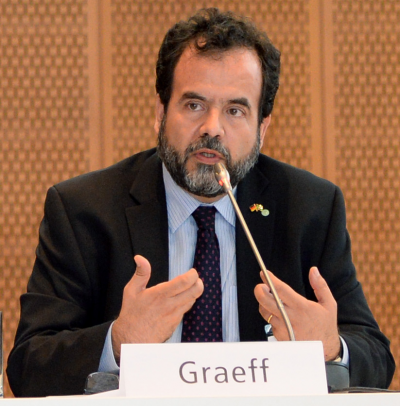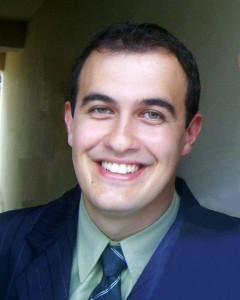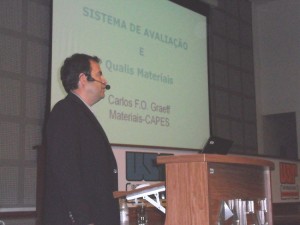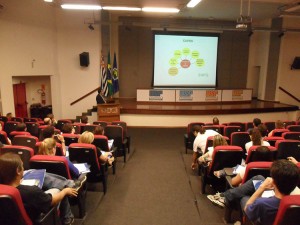For a high-impact, diverse and inclusive science (Workshop Young Researchers’ School)
Sunday, September 16, around 1:00 p.m. City of Natal, State of Rio Grande do Norte, Brazil. The sky was blue and the sea was green. Possibly resisting the temptation of a Sunday afternoon at the beach, about 150 people decided to go to the Convention Center of the traditional Hotel Praiamar, located a few meters from the Ponta Negra Beach – the most famous in the touristic Natal. The reason for this strange decision? To participate in the Young Researchers’ School workshop, a four-hour activity offered at no additional cost to those enrolled in the XVII B-MRS Meeting.
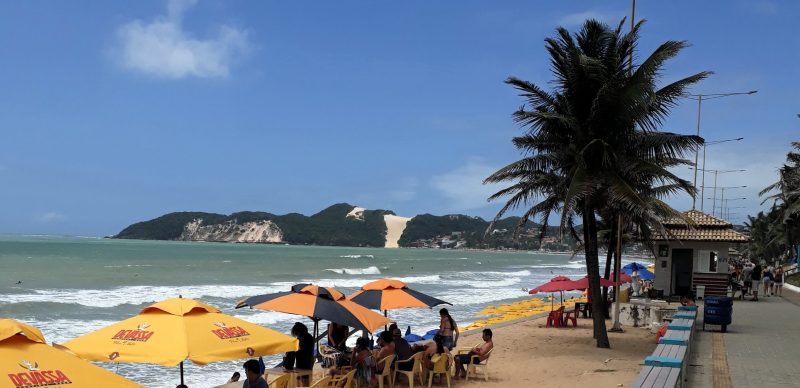
The workshop started with a tutorial by Professor Valtencir Zucolotto (University of São Paulo, USP, Brazil), a member of the Brazilian Materials research community known not only for the research of Nanomedicine and Nanotoxicology Group, but also for the lectures, online courses and workshops on scientific writing and publishing that he creates and presents in Brazil and abroad. Good humored and interacting with the audience, Zucolotto talked about how to do high impact research, from the initial idea to the publication of the paper, covering the research methodology and the writing of the paper. In addition to showing data, Professor Zucolotto shared his experiences “on the two sides of the aisle” (Zucolotto is a productive and cited researcher, as his 42 H index shows, and also edits journals and books). The speaker also gave advice from someone who has gone through this to the younger members of the audience “One must learn to live with rejection, which is part of the work of a scientist,” said Zucolotto, referring to the rejection of papers during the publication process. “Don’t worry, your paper will be rejected… and will be finally accepted in a high-impact journal,” he joked.
[See Professor Zucolotto’s course material at the site http://zucoescrita.com ]
After a generous coffee break sponsored by Elsevier, the workshop continued with the presentation of Elsevier’s Director of Publication of the Materials Science area, Christiane Barranguet, on the diversity and inclusion in the environment of journals and scientific events. In addition to showing data on female participation in science, the director recounted the company’s efforts to achieve gender and geographical diversity and representativeness in the editorial bodies of the journals and in the group of panelists of the conferences. Good results have appeared shyly, she pointed out. However, women and Latin Americans are still underrepresented in these groups. At the end of the lecture, Barranguet invited the Materials community to indicate names of scientists, mainly from underrepresented groups, who could work in the editorial bodies of Elsevier journals.
[See Christiane Barranguet’s presentation file in our Slideshare https://www.slideshare.net/SBPMat/how-can-academic-publishing-increase-diversity-and-inclusion ]
The last part of the workshop returned to the question of the impact of publications, precisely where Professor Zucolotto had stopped. Marlene Silva, also from Elsevier’s Materials team, talked about ways to disseminate a published paper to increase its visibility, citation potential, and academic and social impact. According to the speaker, the dissemination work should be carried out without wasting time, in the pleasure derived from the news of having the paper accepted. One of the most useful tools for this dissemination is, according to Silva, the URL sharing link – made available to the authors of the papers by most of Elsevier’s journals, which grants direct and free access to the paper for 50 days to anyone who receives the link. Silva recommended sharing this link by all possible means, from all social media, accompanied by texts and attractive images, to the author’s e-mail signature. The speaker also talked about strategies to make the article more relevant in search engines, known as SEO, such as repeating the most relevant keywords all along the paper.
[See the presentation file of Marlene Silva in our Slideshare https://www.slideshare.net/SBPMat/how-to-promote-your-article-116520984 ]

Tough, stiff and resilient: the Brazilian materials research community (Opening Ceremony)
A pleasant surprise awaited the approximately 800 participants who settled in the main hall of the Convention Center around 7:30 p.m. to attend the Opening Ceremony. Shortly after the opening words by the master of ceremonies, twelve musicians from the “Orquestra Potiguar de Clarinetas“, from the School of Music of the Federal University of Rio Grande do Norte (UFRN), left their hiding places with their instruments, stood near the stage and filled the room with Brazilian music – mainly compositions from the Northeast region. The musicians showed a sample of the richness and cultural diversity of this country, playing the rhythms of choro, baião, frevo and carimbó.
After the musical presentation, the Opening Table was set up, composed of Professor Antonio Eduardo Martinelli (Chairman of the XVII B-MRS Meeting), Professor Osvaldo Novais de Oliveira Jr (President of B-MRS), Professor Rodrigo Ferrão de Paiva Martins (Second Vice President of the International Union of Materials Research Societies, IUMRS) and Professor José Daniel Diniz Melo (Vice-Rector of UFRN).
Then, those standing on the stage and in the audience, sang the Brazilian National Anthem, accompanied by the Symphony Orchestra and Madrigal Chorus of UFRN projected on the screens scattered throughout the room.
In addition to welcoming and thanking everyone, in the words of the members of the table, there were several references to the social and economic importance of research in Materials. “Knowledge of this area is crucial to solve most of the problems of society,” said Diniz Melo, who is also a professor of undergraduate and postgraduate studies in Materials at UFRN. The Portuguese Rodrigo Martins, who besides being an internationally prominent Materials scientist, is a frequent participant in the B-MRS Meetings, highlighted the role of materials in the development of a country. “From life sciences to aerospace industry, materials are central to all developments and bring a better quality of life to the population,” said Martins. “This event is a celebration of what Materials Science has done for the society,” said Professor Oliveira Junior.
In an inspiring opening speech, Professor Martinelli addressed a subject that has troubled the Brazilian scientific community. “Not only economic difficulties but mainly the sense of what are and what are note priorities for our country have burned part of our past and challenged the best chances to improve Science and Technology in Brazil, putting at risk a better future for current and future generations,” said the chair of the event, who is a professor of undergraduate and post-graduate studies in Materials at UFRN and coordinator of the Materials Area at the federal agency CAPES. The chair highlighted the strength of the Materials community that, even within this context, has remained active and allowed the event to take place, with a large number of participants. “We are materials people: tough, stiff and resilient,” Martinelli said. “No one has given up, and no one will”.

Tributes to prominent members of the community (Memorial Lecture “Joaquim da Costa Ribeiro”)
After the words by the members of the table, the moment came for B-MRS to pay tribute to the long and distinguished trajectory of Brazilian scientists. The first tribute, which was not announced in the program, was for Professor Aloísio Nelmo Klein (Federal University of Santa Catarina, Brazil), who received a commemorative plaque and a gift for his “35 years dedicated to Applied Science.” In fact, Klein’s scientific career stands out mainly by the number of patents (more than 60 applications filed in offices in Brazil, Europe, the United States, China, South Korea, Japan, Taiwan, Singapore and Australia) and numerous projects in partnership with companies. Professor Klein, who is a founding member of B-MRS and has previously served as scientific director, adviser and chairman of two annual meetings of the society, received gratitude and recognition from the president of B-MRS for his long-term dedication to this society.
[See the February 2017 interview with Professor Aloísio Nelmo Klein https://www.sbpmat.org.br/en/gente-da-comunidade-entrevista-com-o-pesquisador-aloisio-nelmo-klein/ ]
The second person to be honored that night was Professor Fernando Galembeck, retired from UNICAMP since 2011, but still active, who is also Collaborating Professor of that university. Throughout the four decades of his scientific career, Galembeck made important contributions to applied and basic research in diverse subjects such as surface modification, nanoparticles, nanocomposites, electrostatics, materials derived from biomass, among other subjects. He is the author of more than 250 papers, 35 patents and 20 books or book chapters, and has more than 3,700 citations. He was a founding member of B-MRS.
[See interview of Fernando Galembeck, updated and reissued in August 2018 https://www.sbpmat.org.br/en/cientista-em-destaque-entrevista-com-fernando-galembeck-que-proferira-a-palestra-memorial-no-xvii-encontro-da-sbpmat-reedicao-atualizada-de-entrevista-de-maio-de-2015/ ].
Galembeck was chosen this year to receive the main B-MRS honor for researchers with an outstanding trajectory in the area of Materials, the Memorial Lecture “Joaquim da Costa Ribeiro”. This distinction also honors, through its name, a pioneer of experimental Materials research in Brazil.
[See article on Joaquim da Costa Ribeiro https://www.sbpmat.org.br/en/historia-da-pesquisa-em-materiais-joaquim-da-costa-ribeiro-e-o-efeito-termodieletrico/ ]
In the first part of his talk, Galembeck addressed the relationship between raw materials, energy and food, given that hunger is still a problem for humanity, and that energy generation can compete with food production by using the same raw materials. This situation worsens, said Galembeck, when financial speculation comes into play. However, he urged, thanks to technological advances, it is possible to produce goods by combining cheap energy from inexhaustible sources like the sun and wind, with abundant raw materials such as lithium, magnesium and carbon dioxide, or even waste. “Waste is untapped opportunity,” highlighted the speaker. With respect to the use of biomass in developing countries, he stated that, in addition to generating energy by reducing the country’s dependence on fossil fuels, it can be used as raw material for high added value products, generating better income for the population. In the second part of the lecture, Galembeck presented an overview of some of his scientific contributions. The scientist also expressed his optimism about the crisis that Brazil is going through, which was addressed earlier by Professor Martinelli. “I’m experienced enough to know that in the end everything will be better than expected,” he stated.
[See Fernando Galembeck’s presentation file in our Slideshare https://www.slideshare.net/SBPMat/materials-for-a-better-future ]
After the lecture, the participants left the Convention Center and, a few meters away, were able to enjoy the welcome cocktail of the event, held in an outside lounge of Hotel Praiamar, enjoying the sea breeze under a starry sky with a crescent moon.

Theory and experiments, industry and academia and multidisciplinarity (Oral and Poster Sessions of the symposia)
The Brazilian members of the materials research community, who were majority in the event, has remained active throughout this difficult year, said the chair at the opening of the meeting. This could be confirmed by simply sitting down in the oral presentation rooms or walking by the poster’s white tent (preferably with a smartphone in hand, to access and save the abstract and data of the posters of interest).
More than a thousand Materials research professionals and students presented their works and discussed them with their peers at the XVII B-MRS Meeting. Despite the high percentage of those enrolled with approved papers who did not attend the event (about 30%), most likely due to of the lack of funding, the symposia held significant participation in the oral and poster sessions. Some symposium organizers went beyond these traditional presentation formats and included discussion forums in their programs. They broke with the linear sitting arrangements and encouraged collective discussions in semicircles, regarding topics they considered as particularly important. Another highlight of the symposia this year, according to the organizers, was the quality of the invited lectures (30-minute presentations given by experts on topics within the scope of the symposium, which are invited by the organizers).
The thematic range covered by the symposia was once again broad and comprehensive. Many materials were covered (nanomaterials, conductive polymers, advanced metals, composites, metal oxides, electroceramics, biomaterials, surfaces, coatings). Many applications were presented (for the segments of energy, aerospace, health, electronics, bioelectronics, photonics, automotive, decorative). Several interactions took place: between different people, between the theoretical and the experimental, between industry and academia, between science and technology, between areas of knowledge (Chemistry, Physics, Biology, Engineering, Medicine).
Among the symposia of this edition of the event, there were old acquaintances (such as the Brazilian Eletroceramics Symposium, in its eleventh edition), newer symposia (such as the one about Surface Engineering) and totally new symposiums, such as the symposium on nanofibers and applications.
The symposia of the XVII B-MRS Meeting were organized by 76 researchers linked to education and research institutions or companies from Brazil, Argentina, Canada, Chile, Germany, Portugal, Spain, and USA.
[See the highlights of the symposiums, sent by some of the organizers https://www.sbpmat.org.br/en/xvii-b-mrs-meeting-highlights-of-the-symposia/]

Lectures on scientific instrumentation
Located between the entrance to the Convention Center and the Secretariat of the event, on the way to the plenary lecture room, the exhibitors’ area was full of activity, and not just during the coffee break, which was served at the event. Twenty companies and UFRN were there with their booths staffed by specialists, their publicity materials, gifts and, in some cases, equipment for demonstrations. In addition, on Wednesday, some of the scientific instrumentation companies offered ten technical lectures showing the advances and the new applications of various characterization techniques, as well as innovations in laboratory equipment.
And the participation of the exhibitors went beyond the technical specifics. Solidus, a junior company of Materials and Mechanical Engineering that participated in the event at the UFRN booth provided a photo frame for visitors who wanted to take a souvenir photo of the XVII B-MRS Meeting and share it in social networks.

Student proposals for the future Aerospace Industry (The “Aerospace Materials and Manufacturing for the Next Century” challenge)
One of the highlights of the event was the technological challenge of the aerospace industry for undergraduate and graduate students attending the meeting. In order to motivate students to carry out multidisciplinary research with aerospace applications, and to bring the academic environment and industry closer together, the activity was conceived and organized by a group of researchers from Brazilian universities and two leading companies in the aerospace segment, the US Boeing and the Brazilian Embraer.
The activity began on Monday, September 17, when 55 students, interested in participating in the challenge previously announced by the B-MRS channels, registered at the Boeing booth (Diamond Sponsor of the event), located in the exhibitors’ area of the convention center. At the end of the day, a lottery defined who would be the participants in this challenge.
The following day, at lunchtime, experts presented six technical challenges related to problems or opportunities in the aerospace industry for 36 students who were having lunch in the audience – the lunch boxes were sponsored by Boeing. After the presentations, the students formed the respective work teams.
24 hours later, the six groups had to present their solutions in English, while they were evaluated in terms of originality, technical content, alignment with the proposed challenge, solution implementation potential and presentation quality. The jury consisted of nine researchers from the Materials area of Brazil and abroad, linked to Boeing, Embraer, as well as education and research institutions.
The following day, during the Awards Ceremony of the event, Catherine Parrish, Senior Coordinator of Materials and Process Engineering Research at Boeing, and Fabio Santos da Silva, Senior Technology Development Engineer at Embraer, announced the winning work and delivered diplomas and gifts to the members of the winning team, composed of five masters and PhD students in Materials, Chemistry and Physics from institutions in the South, Northeast and Midwest regions of Brazil. “We are very happy with the results of the challenge. The participants presented really innovative ideas; it was fantastic,” Parrish said.
Responding to the challenge “Aerospace Structures and Systems Inspired by Nature – Lotus Leaf,” the winning team presented the properties of the lotus leaf, especially its super-hydrophobia and its consequent self-cleaning ability. The students suggested applications in the aerospace segment (mainly in the aircraft fuselage) of materials with lotus leaf-inspired surfaces, and proposed ways to obtain these surfaces. “What I learned from this challenge was that staying calm is very important for developing a project, and helping others wherever possible. Each one gives their contribution and together we add individual skills,” states Angelica Belchior Vital, Ph.D. student in Chemical Engineering at UFRN and a member of the award-winning team. “We had a great time and we were really excited with the ideas and discussions the work generated,” she adds.

Sustainability and academic and social impact in the views of world-renowned scientists (Plenary lectures)
Two plenary lectures per day. Eight scientists with outstanding trajectory shared with the participants throughout their expertise in subjects of great academic, social and economic impact. Pillars of the B-MRS meetings, the plenary lectures of this edition of the event gathered a few hundred participants and showed the crucial role of Materials research in subjects such as sustainability and health.
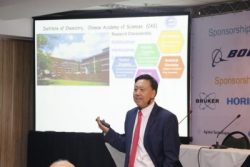
At the first plenary session of the event, Professor Junbai Li, from the Institute of Chemistry of the Chinese Academy of Sciences, revealed how he helps nature to assemble nano and micro structures from biological molecules. More precisely, Li, who is the editor-in-chief of Colloids & Surfaces A (Elsevier) and editor of the self-assembly section at Current Opinion in Colloid & Interface Science (Elsevier), uses a type of amino acid (peptides) as basic block to form structures by means of self-assembly processes. The prominent Chinese scientist is able to control the architecture of structures, generating shapes similar to tubes, platelets, vesicles or flowers. The lecturer showed that these biocompatible structures can be used to staunch bleeding, cure skin diseases and carry drugs. At the end of the lecture, he ensured that peptide-based materials will be part of everyday life in a few years.
[See the plenary file of Junbai Li in our Slideshare https://www.slideshare.net/SBPMat/molecular-assembly-of-peptide-based-materials-towards-biomedical-application ]
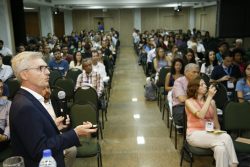
The afternoon plenary was delivered by a scientist who has been working for 25 years at the R&D of Vacuumschmelze, a manufacturer of advanced magnetic materials and related products, born in Germany and present in dozens of countries. Christian Polak spoke about some of the materials developed in the company (amorphous and nanocrystalline magnetic alloys), their manufacturing processes and their applications in products that are part of the company’s portfolio; for example, transformers, converters and electric current sensors. In the lecture, it was possible to verify that the application of highly specialized scientific knowledge results in widely marketed products and innovations that accompany the demands of the consumer market, such as components to improve the performance of smartphones.
[See the plenary file of Christian Polak in our Slideshare https://www.slideshare.net/SBPMat/soft-magnetic-nanocrystalline-materials-for-inductors-and-shielding-applications-optimized-for-higher-frequencies]
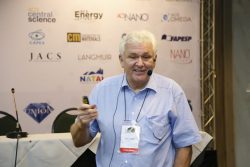
On Tuesday morning, the plenary lecture was given by Heinz von Seggern, former researcher of the famous Bell Labs and Siemens research center, and retired but still very active Professor of the Faculty of Materials Science at the Technical University of Darmstadt (Germany). Seggern spoke about ferroelectric polymers – materials that have, spontaneously and permanently, polarized electric charges – a characteristic that can be used in several applications, such as the well-known electret microphones. From a historical perspective, Seggern showed advances in the understanding, manufacture, characterization and application of some of these materials. In this narrative, Seggern referred to Brazilian researchers who are participating members of B-MRS, such as Professors Sérgio Mascarenhas, José Giacometti and Roberto Faria, as well as the German scientist Bernhard Gross, who came to Brazil in the 1930s and was a pioneer in Materials research in the country.
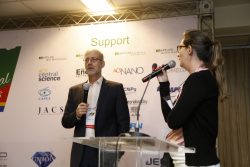
And after three plenary sessions foccusing applied research, Professor Bernhard Keimer (h index =86), in a lecture he himself classified as purely fundamental research, showed the experimental efforts he has been doing with his group at the Max Planck Institute for Solid State Research (Germany) to understand and control collective electron behaviors, more precisely the so-called “electronic correlations,” that would be responsible for generating phenomena as interesting as superconductivity. To carry out his studies, Keimer, who is director of this institute, creates “heterostructures”, which combine very thin layers of various materials (primarily metallic oxides). These are quantum materials – those whose macroscopic properties depend on the properties or behavior of their electrons. Keimer and his colleagues analyze these materials using advanced spectroscopy techniques, thus manage not only to understand but also to begin to control the correlations among small and difficult-to-study entities such as spins and charges.
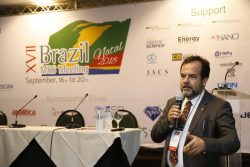
The relationship between energy, materials and sustainability returned to the plenary sessions on Wednesday morning in the lecture of Brazilian scientist Carlos Frederico Oliveira Graeff, Professor and Pro-Rector of Research at UNESP (Brazil). The speech began with an overview on the use of different sources of energy. Currently 2/3 of the electricity that mankind consumes comes from fossil fuels responsible for the greenhouse effect. Nevertheless, that relationship will change progressively until 2040 due to the significant increase in solar and wind energy in the energy matrix. In fact, these are energy sources capable of delivering energy in quantities much higher than our current human demand (more than 3,000 times in the case of sunlight). After explaining the fundamentals of the photovoltaic effect, responsible for the conversion of sunlight into electricity, Graeff talked about two types of solar cells that can compete with those of silicon – the latter already widely marketed. The scientist showed the advantages and disadvantages of dye-based and perovskite-based solar cells, and cited the contributions his research group and collaborators have made to the development of these devices. The success of solar cells depends on properly matching a range of materials that work together, said Graeff, casting the challenge to the research community in the room.
[See the plenary file of Carlos Graeff in our Slideshare https://www.slideshare.net/SBPMat/materials-for-the-optimization-of-solar-energy-harvesting ]
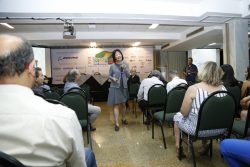
Sustainability also permeated the plenary session of You-Lo Hsieh, Distinguished Professor at UC Davis (USA). The scientist placed the current moment in the second industrial revolution, initiated around 1850 and driven by the use of oil to generate energy and plastic materials, and by the advances in Materials Science and Engineering. On the one hand this revolution brought products that make human life more comfortable, said Hsieh, but it also increased by thousands of times the carbon dioxide emissions and created pockets of litter in the oceans, to name just a few of the consequences. Hsieh develops new materials, such as nanofibers and biopolymeric aerogels, which could make up a different economy, based on low environmental impact chemical processes and on the use of biomass (the set of living organisms, from bacteria to animal or vegetable waste). With the partnership of companies, she hopes to transform these materials into new products that generate new markets. Professor Hsieh pointed some challenges of implementing such an economy, from connecting technology development to market demands, to achieving consumer acceptance.
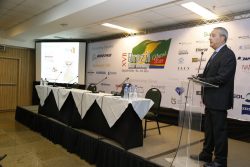
Biomedical applications returned in the penultimate plenary of the event. Pietro Matricardi, Professor at the University of Rome “La Spienza”, spoke about his work with hydrogels (gels with high water content) based on polysaccharides (natural polymers composed of long chains of simple sugars, monosaccharides). Matricardi explained that the hydrogel combined with the polysaccharide can form an intelligent material capable of adhering to living tissues, covering their surface without leaving interstices and interacting positively with them. The gel can also be carried with some drug or compound, which will be released gradually into living tissues. In collaboration with a dentist, Matricardi tested the effects of his hydrogel, loaded with an anti-inflammatory and hydroxyapatite (used for bone regeneration) in patients with severe periodontitis, and they could see very good results. In its nano version, when properly manufactured the hydrogel can carry one or more drugs within the organism and deliver them at the right measure and place. Such is the case of a prostate cancer treatment drug which should be administered together with an anti-inflammatory. Nanohydrogels, whether or not loaded with drugs, may also function to treat skin bacterial infections, as demonstrated by good results from studies conducted with rats by Matricardi.
[See Joan Ramón Morante Lleonart’s plenary file in our Slideshare https://www.slideshare.net/SBPMat/polysaccharide-hydrogels-a-versatile-tool-for-biomedical-and-pharmaceutical-applications ]
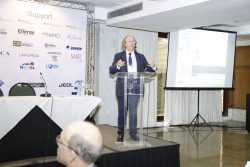
The last plenary lecture of the event began with an image that is as well known as it is worrying: increasing carbon dioxide emissions and global warming. “The circular economy of carbon dioxide is a major challenge for humanity,” said lecturer Joan Ramón Morante Lleonart (h index=82), director of the Institute of Energy Research of Catalonia (IREC), professor at the University of Barcelona and editor of the Journal of Physics D. This concept refers to removing from the environment the excess of carbon dioxide generated by human activities, capturing it and transforming the molecule into useful compounds (such as methanol, methane or formic acid), capable of generating products and fuels. To break the CO2 molecule at an industrial scale requires a lot of energy, which can ideally be obtained from renewable sources. Throughout this “recycling” process of carbon dioxide, materials once again play crucial roles. However, the existing materials generally do not effectively meet, in real conditions, the needs for this recycling to become a reality. Professor Morante pointed out a series of challenges for Materials Science and Technology, related to the development or improvement of nanomaterials for the capture and purification of carbon dioxide, materials for cathodes and anodes used in photoelectric processes, corrosion resistant materials for reactors and, mainly, catalytic nanomaterials for the reduction of carbon dioxide. The plenary closed the technical program of the event with a very encouraging image: that of a typical house of the circular carbon economy. This house does not need fossil fuels to meet the needs of its residents; it consumes sun, wind, air and water, it produces all the electricity and fuels it needs, and returns to the environment only fresh air.

